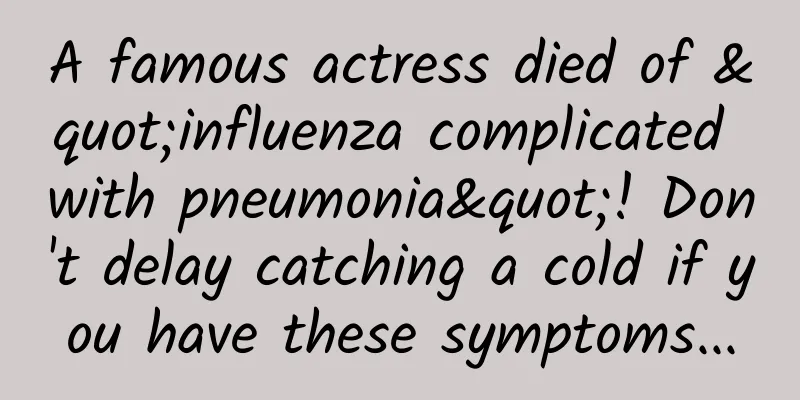A famous actress died of "influenza complicated with pneumonia"! Don't delay catching a cold if you have these symptoms...

|
According to The Paper, Taiwanese actress, singer and host Barbie Hsu (Big S) died of influenza-related pneumonia at the age of 48. Influenza is called "influenza" in Chinese. Because it contains the word "cold", many people think it is the common cold and take it lightly. But in fact, getting the flu may cause serious consequences and may even be life-threatening. According to WHO estimates, influenza can cause 3 million to 5 million severe illnesses and 290,000 to 650,000 respiratory disease-related deaths each year worldwide. A global research data estimated the mortality rate in 33 countries from 1999 to 2015, and the estimated average annual influenza-related mortality rate is as follows: pneumonia The most common complications of influenza Clinically, people under 5 years old, 65 years old or older (some guidelines limit it to over 50 years old), pregnant women, people within 2 weeks of giving birth, and people with chronic underlying diseases are listed as high-risk groups for complications. Healthy young and middle-aged people have a low risk of complications from influenza, but the risk cannot be ignored. Source: References Pneumonia is the most common complication of influenza and is typically characterized by cough with dyspnea, tachypnea (> 24 breaths/minute), hypoxia, and fever (> 3 days). Types of pneumonia include: Primary influenza virus pneumonia: high fever persists 3 to 5 days after the onset of influenza, as well as the above pneumonia symptoms. It is usually very serious and may progress quickly. Without active intervention, it may be life-threatening, especially for people with lung or cardiovascular diseases. Secondary bacterial pneumonia: After the flu symptoms have improved (including fever subsides), fever and coughing up purulent sputum reappear. Usually occurs a few days after the flu (7-14 days), the most common, accounting for about 1/3 of severe flu, and secondary Staphylococcus aureus pneumonia is often critical. Mixed bacterial and viral pneumonia: Referring to the above two, it can manifest as gradually worsening symptoms, or it can manifest as a brief improvement followed by worsening. These flu complications should also be noted In addition to pneumonia, there are other complications of influenza that you should be aware of: 1 Heart complications Myocardial ischemia, myocardial infarction, and heart failure account for about 12% of influenza in adults, but influenza myocarditis and pericarditis are rare. 2 Central nervous system complications Seizures are more common in children and patients with epilepsy, influenza-associated encephalopathy is more common in children, and influenza-induced encephalitis, cerebrovascular accidents, acute disseminated encephalomyelitis, and Guillain-Barré syndrome in adults are generally uncommon. 3 Musculoskeletal complications Severe myositis and rhabdomyolysis (extreme myalgia, weakness, dark urine) are more common in children. Although myalgia is a prominent feature of influenza, true myositis is uncommon. 4 Toxic shock During recent influenza A and B outbreaks, toxic shock-like syndromes have occurred in previously healthy children and adults, often associated with secondary toxigenic staphylococcal infections. 5 Co-infection Including pneumonia (other viruses, bacteria, fungi), bacteremia, meningitis and aspergillosis. Patients with influenza who have a fever for more than 3 to 5 days, who have a fever again after the fever subsides, or whose symptoms continue to worsen after 3 to 5 days of illness need to be vigilant. What is influenza? How is it different from the common cold? 1 Common cold symptoms Typical common colds usually present with obvious nasal discharge and nasal congestion. Other common symptoms include dry throat, itching or pain, cough and discomfort. Adults rarely have fever or low-grade fever due to colds. Cough is more common and often occurs after nasal congestion and nasal discharge. Nasal discharge may be clear or purulent (not necessarily a bacterial infection). 2 Flu symptoms The biggest difference between influenza and the common cold is the severity of the flu. The severity of the flu symptoms varies from person to person. Mild symptoms may be similar to those of a cold, while severe symptoms may result in the complications mentioned above. Taking influenza lightly may cause high-risk groups to neglect vaccination or timely use of antiviral drugs, leading to serious and irreversible consequences. For example, neglecting vaccination can cause influenza to cause serious complex diseases and lead to death in children; for the elderly, this problem may be more hidden, but in clinical practice, we can often see that a seemingly common cold can cause the elderly's physical condition to deteriorate rapidly, or even be unable to recover. It is not always accurate to distinguish between flu and cold based on symptoms. The fastest and most accurate method is pathogen detection. In clinical practice, if you must identify which virus causes a cold, methods include virus culture, antigen detection, and PCR. However, if there is no way to detect it in time, as the disease progresses, there may still be some differences in the symptoms of the two : Globally, influenza causes a large number of hospitalizations and deaths each year, and is a serious public health problem. Even healthy adults may experience severe pain after influenza infection, and the resulting temporary loss of productivity or reduced quality of life is more severe. What should I do if I get the flu? A. Self-judgment For healthy young people (15 to 65 years old), if there are influenza cases in their community, school, office, etc. during the influenza season, and they suddenly develop fever, cough, myalgia or weakness, influenza can be suspected clinically. At this time, influenza testing is not needed for diagnosis. Purchasing antigen home testing is also an option, but due to the sampling technology, the positive accuracy rate may not reach the expected 50% to 70%. When a clear diagnosis is needed, multiple sampling within 1 to 2 days can help improve the positive accuracy rate. In uncomplicated influenza, fever and respiratory symptoms in adults usually last about 3 days, and most will improve afterwards. Full recovery may take 10 to 14 days (older people and those with weakened immune systems may take longer to recover), and fatigue symptoms may persist for several weeks in some patients. Influenza complications, or dehydration (thirst, fatigue, less urine and yellow urine), impaired heart and lung function, or changes in mental status are usually serious illnesses and should be treated in hospital. Copyright images in the gallery. Reprinting and using them may lead to copyright disputes. B When influenza is suspected or confirmed , active antiviral treatment is required if any of the following conditions are met: ① People at high risk of complications: For high-risk groups with influenza, antiviral treatment is recommended regardless of the severity of symptoms or whether the course of the disease exceeds 2 days. ② Contact with high-risk groups: For those who are not high-risk groups for influenza but come into contact with high-risk groups (for example, those who have children or the elderly at home), antiviral treatment is also recommended regardless of the severity of symptoms or whether the course of the disease exceeds 2 days. ③ Influenza persists or is severe: Flu-like symptoms continue to progress for more than 3 days, or influenza complications or severe illness occur. If the illness is severe or lasts for more than 2 days, it is recommended to follow the doctor's advice and use the corresponding antiviral drugs for timely treatment. C does not belong to the above three situations. Weigh the pros and cons before taking the medicine: If the course of the disease is within 48 hours, you can communicate with the doctor to decide whether to give antiviral treatment based on your own life, work or study needs, because mild influenza can heal itself, and drugs can shorten the course of the disease, but at the same time there is an increased risk of drug resistance. If the illness has lasted for more than 48 hours and does not meet the above three conditions requiring medication, antiviral treatment is not recommended. Key Points Flu can be very harmful and can easily cause serious complications, especially fatal to high-risk groups. Therefore, we must attach great importance to flu vaccination!!! September and October are usually good times to get a flu shot, but even if you don’t get the shot before the end of October, you can still get it during the flu season. And because the flu virus is prone to mutation, the flu strains may change every year, so the flu shot should be taken every year!!! Planning and production Author: Fan Yunzhu, attending physician of Jiahui Medical; Chen Mo'ao, popular science author Review | Li Dongzeng, Chief Physician, Department of Respiratory and Infectious Diseases, Beijing Youan Hospital Editor: Yang Yaping Proofread by Xu Lailinlin |
>>: DeepSeek provides its own prompts, with templates and examples, making it more efficient to use!
Recommend
How much does it cost to customize the Liuzhou Automobile Mini Program? Liuzhou Automobile Mini Program Customized Price Inquiry
The mini program provides convenience for publici...
Implementing Audio Graphs in SwiftUI
Preface Graphs are one of those complicated thing...
Games are the savior of smart wearables
Smart wearables are facing a difficult period of ...
How to play the media matrix in new media operations, analyze mainstream media platforms from three dimensions!
Preface: The earliest batch of self-media people ...
The "formula for becoming popular" summarized after 10 years of marketing experience, 99% of the hot spots became popular this way!
"Formula for going viral": creating sur...
Case Practice | Is scanning QR code for door-to-door marketing still effective in 2021?
It’s already 2021, is door-to-door QR code scanni...
Complete channel drainage in 4 steps to double your new customer acquisition and conversion efficiency!
When many online education companies are first es...
A complete guide to operating and promoting Tik Tok!
Do you know how to use Tik Tok, which has huge tr...
Android Tianying Leyue web reader source code download
Functional classification: Entertainment Supporte...
Zhihu operation full set of detailed operation guide
The full text is about 5,000 words, and it takes ...
How to find needs in the scene? In-depth use of "5W2H" to find the key
Going back to the scenario to find needs is an es...
Christmas marketing, see how it is done abroad
Christmas marketing , see how it is done abroad F...
11 common mistakes that new entrepreneurs make
[[155037]] The process of starting a business is ...
Fat goes to where it's cold, so exposed areas are more likely to grow fat? See the proof
In winter, when the temperature is low, will fat ...









